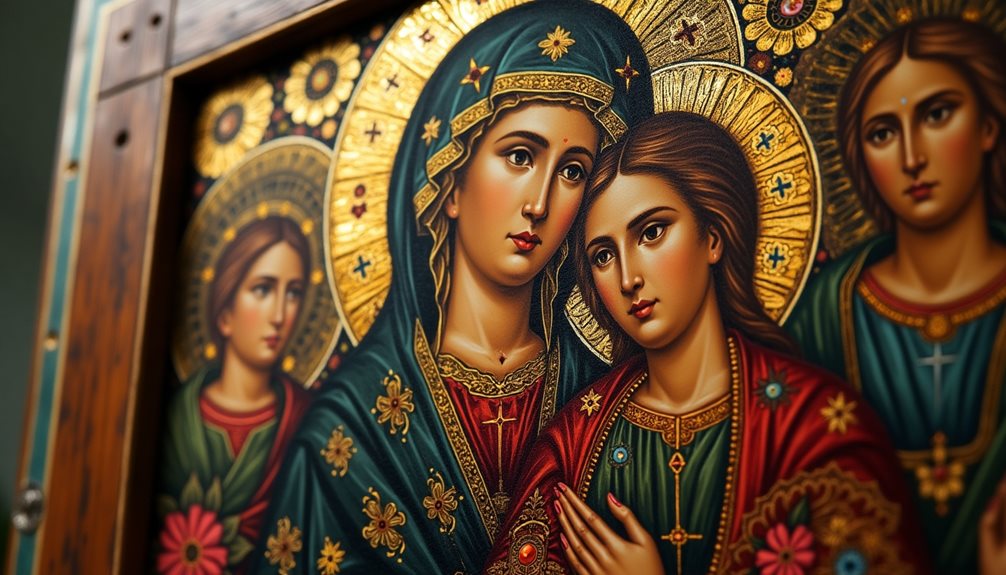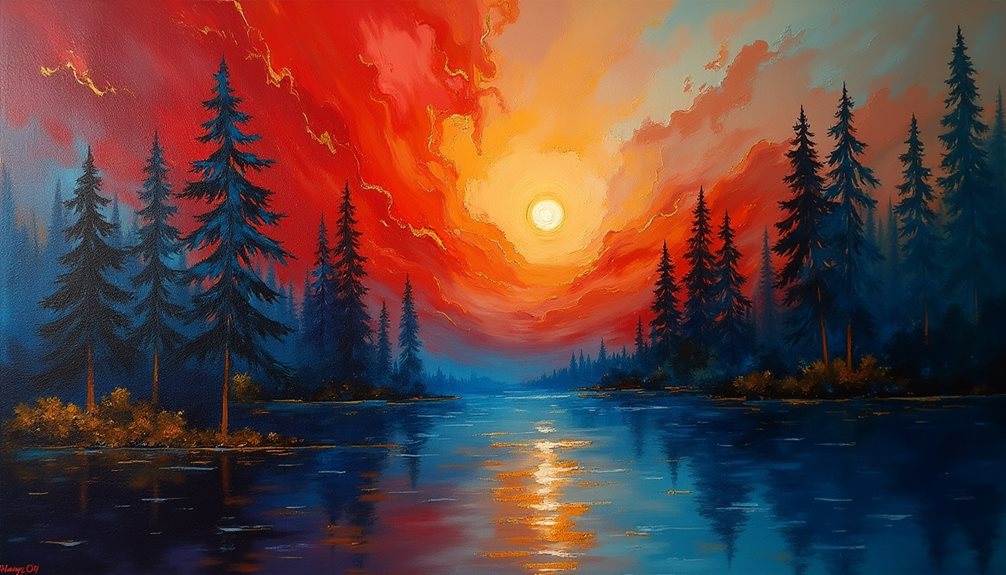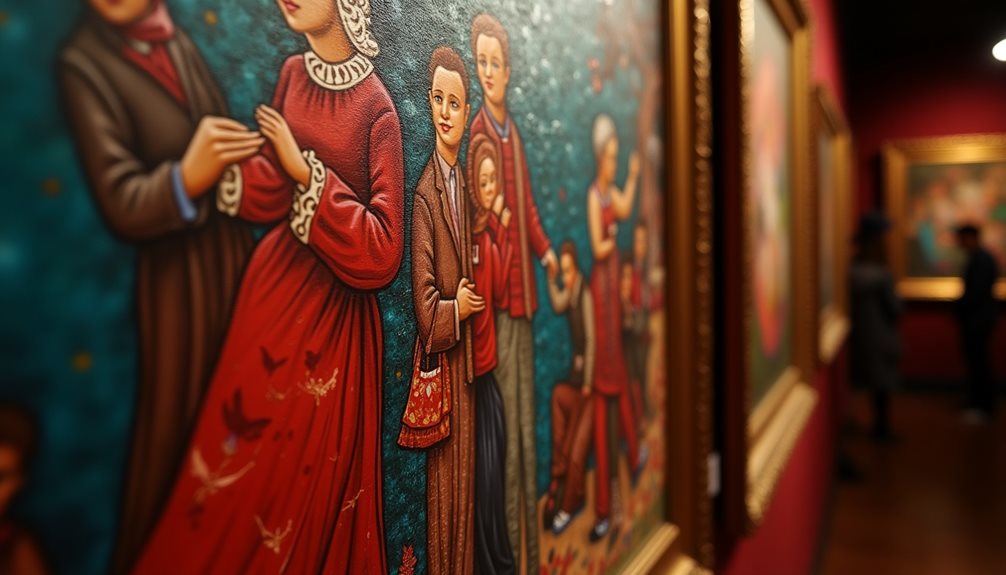Table of Contents
ToggleIconography in Russian Art
How does iconography in Russian art reflect the nation’s complex cultural and spiritual landscape?
Russian art’s iconography serves as a vivid fabric woven from strands of religious symbolism and cultural heritage. Each image, meticulously crafted, conveys profound narratives that resonate with the spiritual and historical consciousness of the Russian people.
Icons, often depicting saints and biblical scenes, are not mere decorations; they embody a dialogue between the divine and the earthly, inviting viewers to engage with the sacred.
This rich visual language reflects the intertwining of Orthodox Christianity with indigenous beliefs, showcasing a society in search of identity and meaning.
In this way, the iconography encapsulates the essence of Russia’s multifaceted cultural narrative, revealing the depths of its spiritual aspirations and artistic expression.
Russian Art and Culture Vocabulary Terms
| Russian (Cyrillic) | English Phonetic | English Definition |
|---|---|---|
| искусство | iskusstvo | Art |
| художник | khudozhnik | Artist |
| картина | kartina | Painting |
| скульптура | skul’ptura | Sculpture |
| галерея | galereya | Gallery |
| музей | muzey | Museum |
| выставка | vystavka | Exhibition |
| мастерская | masterskaya | Workshop |
| портрет | portret | Portrait |
| пейзаж | peyzazh | Landscape |
| живопись | zhivopis’ | Painting (the art of painting) |
| кисть | kist’ | Brush |
| холст | kholst | Canvas |
| произведение | proizvedeniye | Work (of art) |
| эпоха | epokha | Era/Period |
| стиль | stil’ | Style |
| традиция | traditsiya | Tradition |
| символика | simvolika | Symbolism |
| абстракция | abstraktsiya | Abstraction |
| реализм | realizm | Realism |
| авангард | avangard | Avant-garde |
The Role of Folklore in Artistic Expression
While the foundations of Russian art are deeply rooted in religious iconography, folklore emerges as an essential force that enriches artistic expression, reflecting the diverse cultural fabric of the nation. Folklore motifs serve as a bridge between the past and present, imbuing artworks with layers of meaning tied to cultural heritage. Artists draw inspiration from traditional tales, songs, and rituals, enabling a dialogue between generations. This interplay not only preserves but also revitalizes the essence of Russian identity.
| Folklore Element | Artistic Representation | Cultural Significance |
|---|---|---|
| Traditional Tales | Narrative Paintings | Communal Memory |
| Folk Songs | Musical Compositions | Emotional Resonance |
| Rituals | Performance Art | Spiritual Connection |
| Mythical Creatures | Sculpture | Symbolic Interpretation |
Important Movements in Russian Art History
The rich fabric of Russian art history is marked by several significant movements that reflect the complexities of the nation’s social, political, and cultural evolution.
Among these, avant garde movements emerged in the early 20th century, championing innovative techniques and radical expressions that challenged traditional norms. Artists like Kazimir Malevich and Wassily Kandinsky sought to transcend reality, emphasizing abstraction and emotional resonance.
In contrast, socialist realism became dominant post-revolution, serving as a tool for political propaganda and promoting the values of the Soviet regime. This movement aimed to inspire optimism and collective identity through accessible imagery, often depicting heroic laborers and idealized scenes of Soviet life.
Together, these movements encapsulate the dynamic interplay between artistic freedom and ideological constraints in Russian history.

Key Figures in Russian Literature and Their Influence
Russian literature boasts an impressive lineage of key figures whose works have profoundly influenced both national identity and global literary traditions. Notable authors such as Fyodor Dostoevsky and Leo Tolstoy employed literary symbolism to explore the human condition, grappling with themes of morality, faith, and existentialism. Their narratives, often rich in psychological depth, have shaped modern storytelling.
Additionally, poets like Anna Akhmatova and Vladimir Mayakovsky revolutionized poetic forms, blending traditional structures with avant-garde techniques to reflect the tumultuous socio-political landscape of their time.
The interplay of such diverse voices not only enriched Russian literature but also inspired countless writers worldwide, emphasizing the universal quest for understanding and freedom within the human experience.
Understanding the Concept of “Soul” in Russian Culture
Soulfulness permeates the fabric of Russian culture, serving as a profound lens through which individuals understand existence and their place within the cosmos. This concept of the “soul” is deeply intertwined with the essence of Russian identity, reflecting a unique blend of emotional depth and spiritual expression.
In literature, art, and music, soul searching reveals an intrinsic yearning for meaning and connection, often evoking a poignant sense of nostalgia. Artists and thinkers have explored the complexities of the human spirit, capturing the duality of joy and sorrow inherent in life.
This quest for understanding transcends mere aesthetics, becoming a vehicle for personal and collective exploration, ultimately fostering a rich mosaic of cultural narratives that resonate with the universal human experience.
The Significance of Color and Symbolism
Color and symbolism in Russian art and culture serve as powerful conduits for expressing the complex emotional and spiritual landscape of the nation. Through the lens of color psychology, hues are imbued with rich symbolic meanings—red often symbolizes liveliness and revolution, while blue evokes tranquility and spirituality.
Artists harness these colors to convey profound narratives, reflecting the nation’s tumultuous history and cultural nuances. The use of gold in religious iconography represents divine light and eternal truth, reinforcing the deep connection between art and spirituality.

Traditional Russian Music and Its Cultural Impact
While exploring the rich fabric of traditional music, one discovers its profound role in shaping the cultural identity of Russia.
Traditional Russian music, characterized by its diverse regional styles, employs unique traditional instruments such as the balalaika and gusli. Folk melodies convey emotional expression and serve as tools for social commentary, reflecting the historical influences that have shaped the nation.
Key aspects include:
- Cultural preservation through music festivals that celebrate heritage
- The interplay of regional styles that enrich the musical landscape
- The ability of music to foster a sense of community and shared identity
This vibrant musical tradition not only echoes the past but also serves as a living embodiment of Russia’s collective spirit and resilience.
Traditional Russian Music and Its Cultural Impact
Traditional Russian music is a rich and diverse part of Russia’s cultural heritage. It reflects the history, values, and everyday life of the Russian people. For English speakers learning Russian, exploring this topic offers both language practice and cultural insight.
Traditional Russian music includes folk songs, instrumental pieces, and dances. It often features unique instruments and vocal techniques that have been passed down through generations. The themes of the songs usually revolve around nature, love, work, and historical events.
Key Characteristics:
- Melodic: Russian folk music often uses simple, memorable melodies.
- Rhythmic: Many songs have strong rhythms suitable for dancing.
- Vocal Styles: Singing styles can include polyphony (multiple vocal parts) or solo singing with expressive ornamentation.
- Instruments: Common instruments include the balalaika (a triangular stringed instrument), gusli (an ancient multi-stringed instrument), and accordion.
Cultural Impact of Traditional Russian Music
Traditional music plays an important role in Russian society:
- Preserving History: Songs often tell stories from Russia’s past.
- Community Building: Singing and dancing bring people together during celebrations and festivals.
- Identity: Folk music expresses the unique identity of different Russian regions.
- Inspiration: It has influenced classical composers like Tchaikovsky and modern musicians.
Examples of Traditional Russian Songs
- “Kalinka” (Калинка): A lively folk song famous worldwide.
- “Katyusha” (Катюша): A patriotic song from World War II, still popular today.
- “Dark Eyes” (Очи чёрные): A romantic song known internationally.
Related Russian Music Terms for English Learners
| Cyrillic | Phonetic | English Definition |
|---|---|---|
| музыка | mu-ZEE-ka | music |
| народная песня | na-ROD-na-ya PES-nya | folk song |
| балалайка | ba-la-LAI-ka | balalaika (stringed instrument) |
| гусли | GOO-slee | gusli (multi-stringed instrument) |
| аккордеон | ak-ko-RDE-on | accordion |
| певец | pe-VETS | singer (male) |
| певица | pe-VEE-tsa | singer (female) |
| танец | TA-nets | dance |
| мелодия | me-LO-dee-ya | melody |
| праздник | PRAZ-dnik | holiday, celebration |
The Intersection of Politics and Art in Russia
The influence of politics on artistic expression in Russia has been profound and pervasive, shaping the narratives and forms of art throughout history. Under various regimes, art has frequently served as a tool for artistic propaganda, reflecting the prevailing political ideologies and societal values.
From the revolutionary fervor of Constructivism to the repressive constraints of Socialist Realism, artists have navigated complex censorship dynamics, often risking personal freedom to convey dissenting views. This interplay has fostered a unique cultural landscape where art oscillates between celebration and critique.
The tension between political authority and artistic freedom continues to influence contemporary creators, who grapple with the legacy of state control while seeking to reclaim their voices in a rapidly changing society.
Contemporary Trends in Russian Artistic Practices
As contemporary Russian artists navigate a post-Soviet landscape marked by both freedom and uncertainty, their practices reflect a dynamic interplay of global influences and local traditions.
The rise of digital art has allowed for innovative expressions that challenge traditional mediums, enabling artists to explore identity and social commentary in multifaceted ways.
Additionally, street art has emerged as a powerful form of public dialogue, often addressing pressing societal issues while fostering community engagement.
- Artists utilize technology to create immersive experiences.
- Street art serves as a canvas for activism and personal expression.
- Collaborations between local and international artists enrich the cultural dialogue.
Frequently Asked Questions
What Are Common Themes Found in Russian Artworks?
Common themes in Russian artworks frequently explore folk traditions and historical narratives, reflecting the nation’s rich cultural heritage. Artists often intertwine these elements, portraying the struggles and triumphs of the Russian spirit throughout history.
How Does Russian Art Reflect Social Changes?
Russian art mirrors social changes through social realism, depicting everyday struggles and aspirations, while avant-garde movements challenge conventional narratives, reflecting the tumultuous political landscape. This duality captures the evolving identity of society amidst shifting cultural paradigms.
What Are Notable Russian Art Museums to Visit?
Notable Russian art museums include the Hermitage Museum, renowned for its vast collection and architectural grandeur, and the Tretyakov Gallery, celebrated for its extensive showcase of Russian masterpieces, reflecting the nation’s rich cultural heritage and artistic evolution.
How Has Russian Art Influenced Global Artistic Movements?
Russian art, particularly through movements like Russian Impressionism and Soviet Realism, has profoundly influenced global artistic discourse, introducing unique perspectives on emotion and societal reflection, thereby challenging and enriching international artistic narratives and expressions.
What Materials Are Traditionally Used in Russian Art?
Traditional Russian art employs various artistic mediums, prominently featuring natural materials such as wood, clay, and linen. Artists historically utilized traditional pigments derived from minerals and plants, contributing to the rich vibrancy characteristic of this cultural heritage.



